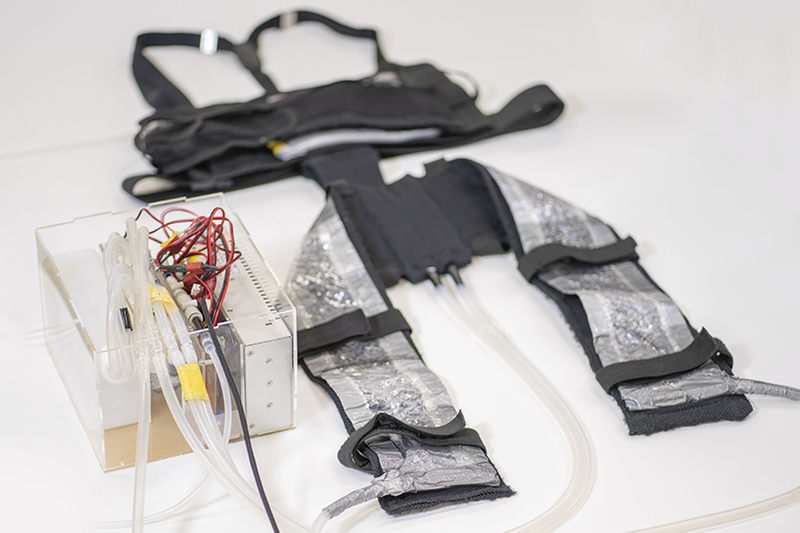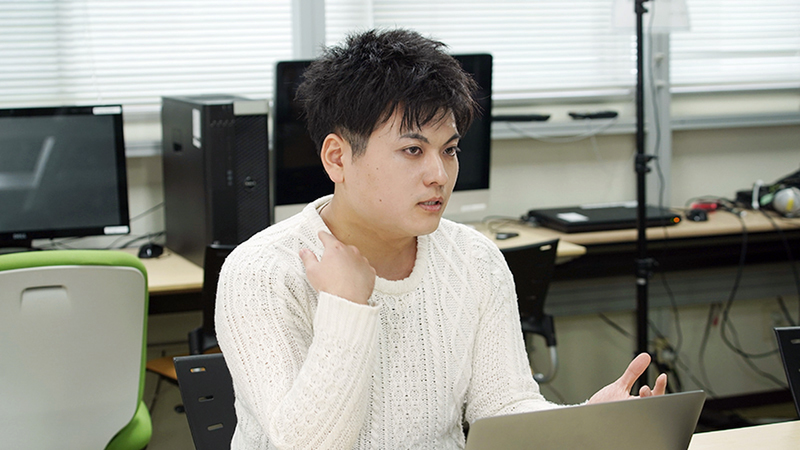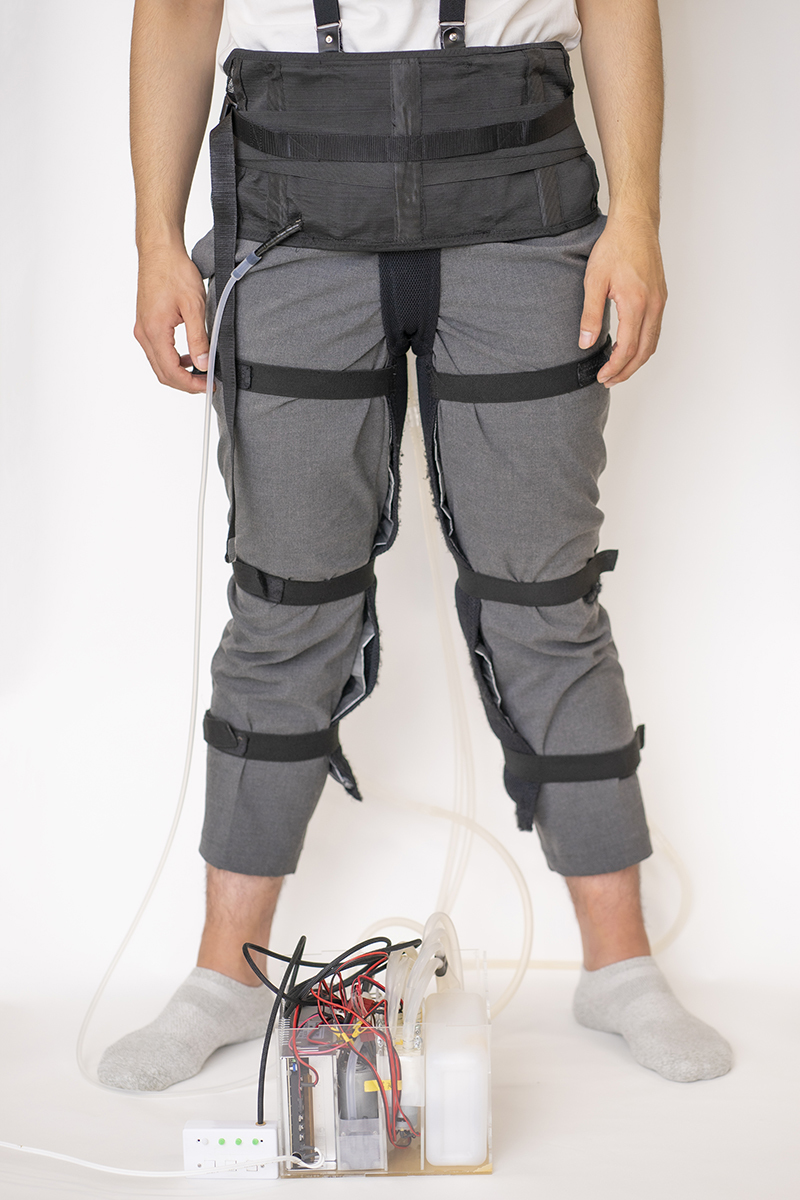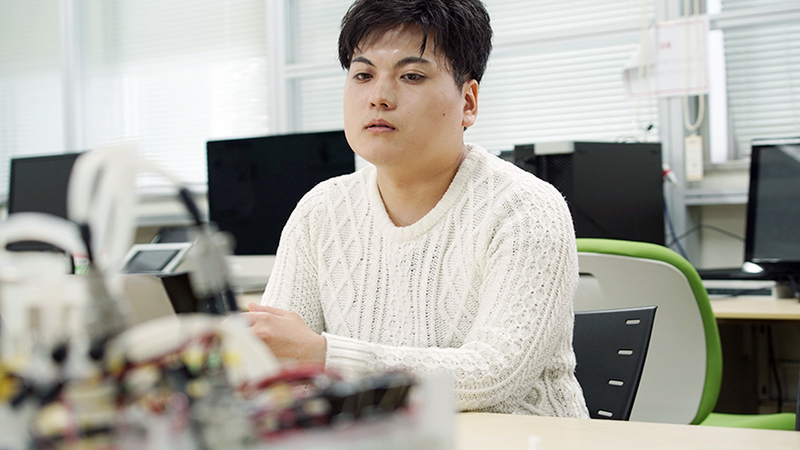Interviews

An “Incontinence” Entertainment Experience! A New Exploration of Senses Through the Simulation of Peeing Yourself!
Takayuki Kameoka
Takayuki Kameoka (University of Electro-Communications Master’s Program Year 2, Kajimoto Lab) transforms “incontinence experience systems” to entertainment content
Interviewer:Kosuke Haneda/Author:Junko Kuboki/Translated by:FUJIYAMA, Co., Ltd./Photography by:addingdesign LLC.

Few people will immediately know what equipment is in the picture. It is a rare incontinence experience device in the world.
The “incontinence experience system (self-wetting sensory device)” is a machine that simulates the experience of incontinence. This eccentric, conceptual machine has now been the focus of six years of diligent work for Takayuki Kameoka.
The Incontinence Study Group
Kameoka founded the “Incontinence Study Group” in 2015; began operations and has since investigated business applications for the device while also engaging in research and studies.
“An artisanal association was what prompted me to do it. We were brainstorming ideas for ‘something fun to make’ at a school festival and the keyword ‘incontinence’ came up. There were a lot of other ideas but for some reason ‘incontinence’ got the best reception.”
“Honestly, I’m still a bit baffled regarding why ‘incontinence’ was so exciting for everyone,” Kameoka says with a laugh, but his decision was the right one. Excretion is a fundamental human activity, and the “comfortable/uncomfortable” sensations we feel during it are the products of complex interactions between our brains, tissues, and organs. Yet the internal processes of our bodies are still shrouded in mystery.
While the group had decided to actually build the incontinence experience system, there wasn’t enough time to complete it. They only showed a presentation on the concept at the school festival but the reaction was unexpected.
“The attendees gave us feedback. A doctor said that ‘it might be useful in rehab for people who lose the ability to excrete properly after surgery,’ and a mother with small children asked ‘could you use it for toilet training in children?’ They had practical ideas.”

Kameoka says that the school festival's offering has become an unexpected development.
The idea also underwent a transformation.
“Our perspective was fixed on ‘wanting to excrete normally, and not be incontinent,’ leading to the conclusion that 'it would be interesting as an experience. But we realized there was an inverted perspective that had never occurred to us of ‘putting it to use in encouraging incontinence and promoting excretion.’”
Kameoka researched existing excretion issues and realized the truth. As we can tell from TV commercials for incontinence pads and diaper products for nursing care, it is not uncommon to suffer from incontinence-related concerns in daily life. Many people have these issues. The simulation experience raises awareness even among those without current issues and also deepens understanding. The system could be a major asset in nursing care training and other medical fields.
Creation of the Device
Finding the theme provocative, Kameoka was also intrigued by the need for engineering creativity and the fun of electrical and mechanical engineering in creating the system.
The first system they created was a chair-based, seated experience. From there, Kameoka shifted to a modular structure with continual size reductions; producing the current Version 6: a standing, wearable device.
The same ideas from the outset are still at work in the system’s structure. An air pressure balloon generates pressure over the abdomen (simulating a full bladder), pumps circulating warm water through internal tubes (simulating the warmth and wetness of incontinence), while cooling fans and a vibrating element create a chill and neck tremors.
“I actually measured the amount of urination and temperature factors. But in temperature terms, there is actually a major difference between urine temperature, skin surface temperature, and the temperature of the warm water in the tubes. Simulating exactly to the data measured doesn’t often produce a realistic-feeling simulation. We adjusted many times for ‘whether the person experiencing the system can sense it.’”
Specifically, they have the water volume set a bit high so users will sense that they urinated, set at 40-50 degrees so that even clothed users can sense it. The experience is performed clothed so that others can view the user, so it also follows a major premise of not getting clothing wet.

The incontinence experience device is worn over clothes and is tied around your legs.

Participant experiencing the incontinence experience device.Hot water (40-50°C), simulating the sensation of urine, flows under clothing.
Making wetting yourself fun
“We are prioritizing the ‘design as an experience’ foremost. We are aiming for an incontinence experience as entertainment,” says Kameoka.
While entertainment might be unexpected, Kameoka is aiming to produce positive content for incontinence – which has an exclusively negative image – while also popularizing the system for nursing care education and medical rehabilitation uses.
At an experience session held in collaboration with a gaming company, smiling users commented that it was “super gross,” “fun,” and “a chance to remember to be careful,” after experiencing the attraction. The experience seems to produce an emotional cycle much like a roller coaster – the thrill and fear before boarding, the anticipation and excitement on the way up, and the relief on getting off – as users move from enduring the need to urinate, on to relief afterwards.
“I think that entertainment is vital in changing our views from sneering at incontinence to laughing together with people who suffer from it,” adds Kameoka.
The Incontinence Research Board (https://urealabyrinth.wixsite.com/incontinence) has begun accepting system rental applications and collaboration plans via its homepage. This is a pillar of Kameoka’s challenge as he aims to become “a researcher with widely-shared views” and “a researcher with business sense, who can work alongside companies.”
Kameoka is still currently engaged in his master's program studies, primarily focused on VR. In the future, this incontinence experience system will include immersion through a head-mounted display for an even more effective incontinence experience. If he can achieve that, users may find the sense of incontinence coming from their own senses and awareness – rather than an external or physical approach.
The Future of Tactile Sensation
Kameoka is also engaged in research on “tactile” sensation. This means that his fields come together to focus on “sticky sensations.” He has begun work on a project to produce a facial sensation of the sticky, viscous sensation we feel with our fingertips. He is not using gloves or other wearable devices, aside from head-mounted displays, and plans to produce this hand-based sensation in the face using just an HMD and suction cups. (The research into "“sticky sensations”" and "integrating a tactile presentation device in a HMD" are related projects, but are currently being started as separate projects.)
Kameoka says that we need to reproduce human sensory perceptions for comprehensive research in this fashion.
“All sorts of sensations are being researched, now. The stickiness I’m working on is one example but so is temperature, rough sensations, smoothness, and other similar textures. If we don’t build up a large body of research on it, we won’t be able to perfectly direct even tactile sensation alone. But if we do, it will tie into a complete understanding of human sensory mechanisms.”
Kameoka also says he would be happy to showcase the incontinence experience system overseas, given the opportunity. In his current research, the overseas response is “numerically unknown.” Even with a strong culture of shame and significant cultural barriers concerning excretion Japan has still been welcoming of the system.
With cultures and countries changing, how will audiences respond to this “incontinence” experience? Given the varying types of responses so far, it seems plausible that we may see a gradual shift in awareness of incontinence experiences both within Japan and abroad.

Aiming for incontinence as entertainment.
Takayuki Kameoka
Kajimoto Laboratory, The University of Electro-Communications, M2. Established the “Incontinence Study Group” in 2014, and has since developed incontinence experience devices as a representative. The specialty field is VR, especially elucidation of the mechanism of the tactile perception and development of the haptics device.

